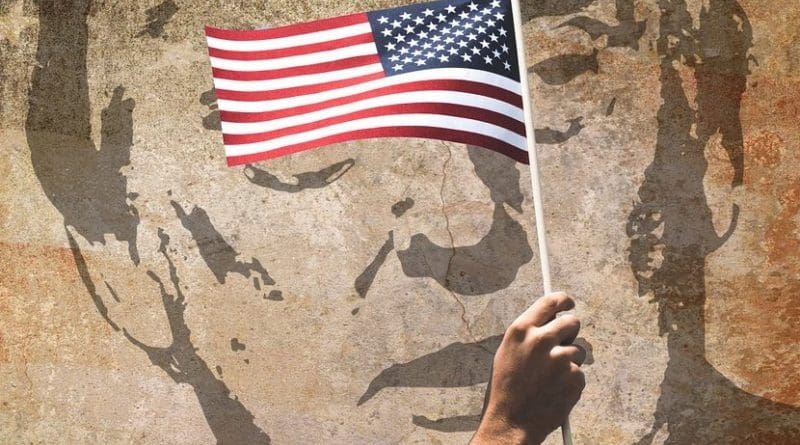Why A Trump 2020 victory Remains On The Cards – OpEd
By Arab News
By Andrew Hammond*
The US Democrats hold their latest presidential debate on Wednesday in a bid to narrow down the party’s still-large 2020 field of candidates. While Donald Trump’s poll figures remain weak, he remains the potential favorite in next year’s election, despite a highly unorthodox, controversial three years in the White House.
While a large body of US and international publics, including this author, have long been critical of Trump, the fact remains that several key economic and political fundamentals are currently acting like “tail-winds” for his re-election in November 2020. This includes the generally robust economy, which continues to hum along in what became in July the longest-ever period of expansion in US history dating back some 121 months, and counting.
In October 2016, just before his election, I wrote that Trump could pull off a surprise win, despite Hillary Clinton’s strong standing in polls. While that outcome was dismissed by some, a number of academic forecasting models pointed to his victory.
A good example is the “time-for-change” model of Prof. Alan Abramovitz which has successfully predicted presidential elections for almost three decades. This forecast is based on three key predictive items — the growth rate of real gross domestic product (GDP) in the second quarter of election year, the incumbent’s approval rating at mid-year in Gallup polls, and whether the incumbent party has held the White House for one presidential term or more.
In 2016, this model pointed to a Trump victory. In part, this is because it included a forecast reduction in vote share for the Democrats reflecting the fact that while presidents frequently win a second term, it is difficult for a party to win three consecutive terms of presidential power as would have been the case if Clinton had won after Obama’s two victories in 2008 and 2012. The last time this “two terms and your out” rule was breached, in 1988, came when George Bush bested Michael Dukakis after two terms of Ronald Reagan’s presidency and, before that, in the 1940s with Franklin Roosevelt.
Turning to 2020, this latter dynamic will be reversed since recent history favors presidents winning a second term with, for instance, the last three incumbents all re-elected. This pattern is also given more historical support by the fact that, since the 1930s, the party which wins the presidency has held the White House for at least two terms of office with only one exception: The Democrats in 1976 when Jimmy Carter failed to get re-elected in 1980 against Reagan.
So despite the fact that Trump is weighed down by a historically weak job approval rating (Gallup’s latest ratings, as of Oct. 31, are 57 percent disapproval and 41 percent approval, a net disapproval of minus 16), his prospects are far from sunk. Indeed, the Abramovitz model suggests Trump (in the likely, but not certain, scenario he is the Republican nominee) could prevail again, especially with real GDP growth of at least 1-2 percent anticipated next year.
Indeed, in April, Abramovitz concluded with the then-latest data, that despite all the controversy of Trump’s presidency, he could receive between 263 and 283 electoral votes, with 270 needed for victory. Of course, this prognosis will improve (or deteriorate) in coming months for Trump the more that his approval improves (or sinks), and the faster (or slower) the economy grows.
Yet, while this means Trump is “still in the game,” his re-election is far from certain. And his chances will be further tarnished if the economy unexpectedly goes south.
The other reasons Abramovitz’s model may be stretched to breaking point in 2020 is that it is based on a number of other assumptions like other academic forecasts. First, it is taken for granted that both Republicans and Democrats nominate relatively mainstream presidential contenders with the capacity to bring their parties together after sometimes divisive primary seasons, and secondly, that both candidates conduct first class, effective campaigns to maximize their national support.
The unorthodox president may fulfil neither of these conditions. He is a wild, maverick candidate rather than mainstream Republican and, with a significant number of “Never Trump” conservatives, may not unify the party in a way that many predecessors have done. It is also far from clear, at this stage at least, that he will run a campaign that maximizes national support, as opposed to consolidating his base.
In these conditions, much will also depend on who the Democrats choose, and how effective the campaign is that she/he runs. And one of the key factors that will influence the party’s prospects of victory will be whether, and how quickly, it can unite around this nominee given the large amount of contenders still in play.
After the policy and personal controversies from Trump’s presidency, many Democratic operatives are keen to avoid a bruising, introspective and drawn-out contest that exposes significant intra-party division to the national electorate, as happened in 2016. Then the contest between Clinton and Bernie Sanders saw key differences opening up which helped contribute to the party losing an election that was potentially winnable given wafer-thin margins of victory for the now-president in several battleground states.
- Andrew Hammond is an Associate at LSE IDEAS at the London School of Economics.

